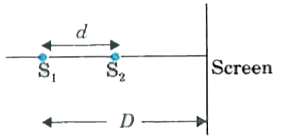
Interference of light is based on the superposition principle according to which at a particular point in the medium the resultant displacement produced by two or more light waves is the vector sum of the displacement produced by the two individual light waves.
A British physicist Thomas Young made two pin holes S1andS2, separated by a very very small distance 'd' on an opaque screen which were illuminated by another pin hole S lit by a monochromatic source of light. so S1andS2 behaves as two coherent sources of light. spherical waves emanating from S1andS2 produce interference fringes on the screen AB. if P be a point situated at a distance x from central point O of the screen, then path difference between the waves coming from the two sources is
S2P−S1P=xdD
Bright fringe is obtained on the screen if path difference xdD is an integer multiple of wavelength λ. However, we get a dark fringe on the screen if the path difference is an odd multiple of λ2.
Q. Will the central point O on the screen be bright or dark?
Text Solution
The central point O is bright because path difference S2O−S1O is zero and the two waves reach in same phase there.
|
Topper's Solved these Questions
- WAVE OPTICSBOOK - U-LIKE SERIESCHAPTER - WAVE OPTICSEXERCISE - MULTIPLE CHOICE QUESTIONS
30 Videos
- WAVE OPTICSBOOK - U-LIKE SERIESCHAPTER - WAVE OPTICSEXERCISE - FILL IN THE BLANKS
13 Videos
- WAVE OPTICSBOOK - U-LIKE SERIESCHAPTER - WAVE OPTICSEXERCISE - ADDITIONAL EXERCISE
13 Videos
- SEMICONDUCTOR ELECTRONICS : MATERIALS, DEVICES AND SIMPLE CIRCUITSBOOK - U-LIKE SERIESCHAPTER - SEMICONDUCTOR ELECTRONICS : MATERIALS, DEVICES AND SIMPLE CIRCUITSEXERCISE - SECTION B
1 Videos
Similar Questions
Knowledge Check
Two coherent point sources S1andS2 are separated by a small distance 'd' as shown. The fringes obtained on the screen will be :
 Astraigth linesBsemi-circleCconcentric circlesDpoints
Astraigth linesBsemi-circleCconcentric circlesDpointsTwo coherent point sources S1 and S2 are separated by a small distance d as shown. The fringes obtained on the screen will be
 ApointsBstraight linesCsemi-circlesDconcentric circles
ApointsBstraight linesCsemi-circlesDconcentric circlesThe optical path difference between the two light waves arriving at a point on the screen is
AxdDBxDdCdxDDdDx
Two coherent point sources S1 and S2 are separated by a small distance d as shown. The fringes obtained on the screen will be

View SolutionIf S1andS2 are two point sources emitting light in phase , then what is the shape of interference fringes formed on the screen ?

View SolutionLight Waves Interference and Thomas Young Experiment
View SolutionTwo coherent sources of light interfere and produce fringe pattern on a screen . For central maximum phase difference between two waves will be
View SolutionTwo coherent sources of light interfere and produce fringe pattern on a screen . For central maximum phase difference between two waves will be
View Solution

